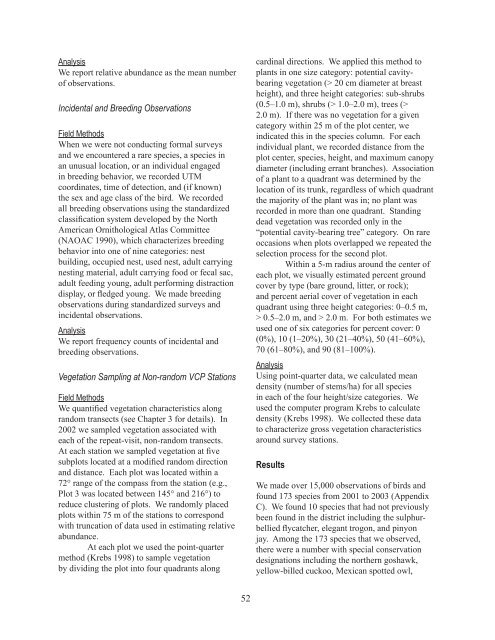Vascular Plant and Vertebrate Inventory of Saguaro ... - USGS
Vascular Plant and Vertebrate Inventory of Saguaro ... - USGS
Vascular Plant and Vertebrate Inventory of Saguaro ... - USGS
You also want an ePaper? Increase the reach of your titles
YUMPU automatically turns print PDFs into web optimized ePapers that Google loves.
Analysis<br />
We report relative abundance as the mean number<br />
<strong>of</strong> observations.<br />
Incidental <strong>and</strong> Breeding Observations<br />
Field Methods<br />
When we were not conducting formal surveys<br />
<strong>and</strong> we encountered a rare species, a species in<br />
an unusual location, or an individual engaged<br />
in breeding behavior, we recorded UTM<br />
coordinates, time <strong>of</strong> detection, <strong>and</strong> (if known)<br />
the sex <strong>and</strong> age class <strong>of</strong> the bird. We recorded<br />
all breeding observations using the st<strong>and</strong>ardized<br />
classification system developed by the North<br />
American Ornithological Atlas Committee<br />
(NAOAC 1990), which characterizes breeding<br />
behavior into one <strong>of</strong> nine categories: nest<br />
building, occupied nest, used nest, adult carrying<br />
nesting material, adult carrying food or fecal sac,<br />
adult feeding young, adult performing distraction<br />
display, or fledged young. We made breeding<br />
observations during st<strong>and</strong>ardized surveys <strong>and</strong><br />
incidental observations.<br />
Analysis<br />
We report frequency counts <strong>of</strong> incidental <strong>and</strong><br />
breeding observations.<br />
Vegetation Sampling at Non-r<strong>and</strong>om VCP Stations<br />
Field Methods<br />
We quantified vegetation characteristics along<br />
r<strong>and</strong>om transects (see Chapter 3 for details). In<br />
2002 we sampled vegetation associated with<br />
each <strong>of</strong> the repeat-visit, non-r<strong>and</strong>om transects.<br />
At each station we sampled vegetation at five<br />
subplots located at a modified r<strong>and</strong>om direction<br />
<strong>and</strong> distance. Each plot was located within a<br />
72° range <strong>of</strong> the compass from the station (e.g.,<br />
Plot 3 was located between 145° <strong>and</strong> 216°) to<br />
reduce clustering <strong>of</strong> plots. We r<strong>and</strong>omly placed<br />
plots within 75 m <strong>of</strong> the stations to correspond<br />
with truncation <strong>of</strong> data used in estimating relative<br />
abundance.<br />
At each plot we used the point-quarter<br />
method (Krebs 1998) to sample vegetation<br />
by dividing the plot into four quadrants along<br />
52<br />
cardinal directions. We applied this method to<br />
plants in one size category: potential cavitybearing<br />
vegetation (> 20 cm diameter at breast<br />
height), <strong>and</strong> three height categories: sub-shrubs<br />
(0.5–1.0 m), shrubs (> 1.0–2.0 m), trees (><br />
2.0 m). If there was no vegetation for a given<br />
category within 25 m <strong>of</strong> the plot center, we<br />
indicated this in the species column. For each<br />
individual plant, we recorded distance from the<br />
plot center, species, height, <strong>and</strong> maximum canopy<br />
diameter (including errant branches). Association<br />
<strong>of</strong> a plant to a quadrant was determined by the<br />
location <strong>of</strong> its trunk, regardless <strong>of</strong> which quadrant<br />
the majority <strong>of</strong> the plant was in; no plant was<br />
recorded in more than one quadrant. St<strong>and</strong>ing<br />
dead vegetation was recorded only in the<br />
“potential cavity-bearing tree” category. On rare<br />
occasions when plots overlapped we repeated the<br />
selection process for the second plot.<br />
Within a 5-m radius around the center <strong>of</strong><br />
each plot, we visually estimated percent ground<br />
cover by type (bare ground, litter, or rock);<br />
<strong>and</strong> percent aerial cover <strong>of</strong> vegetation in each<br />
quadrant using three height categories: 0–0.5 m,<br />
> 0.5–2.0 m, <strong>and</strong> > 2.0 m. For both estimates we<br />
used one <strong>of</strong> six categories for percent cover: 0<br />
(0%), 10 (1–20%), 30 (21–40%), 50 (41–60%),<br />
70 (61–80%), <strong>and</strong> 90 (81–100%).<br />
Analysis<br />
Using point-quarter data, we calculated mean<br />
density (number <strong>of</strong> stems/ha) for all species<br />
in each <strong>of</strong> the four height/size categories. We<br />
used the computer program Krebs to calculate<br />
density (Krebs 1998). We collected these data<br />
to characterize gross vegetation characteristics<br />
around survey stations.<br />
Results<br />
We made over 15,000 observations <strong>of</strong> birds <strong>and</strong><br />
found 173 species from 2001 to 2003 (Appendix<br />
C). We found 10 species that had not previously<br />
been found in the district including the sulphurbellied<br />
flycatcher, elegant trogon, <strong>and</strong> pinyon<br />
jay. Among the 173 species that we observed,<br />
there were a number with special conservation<br />
designations including the northern goshawk,<br />
yellow-billed cuckoo, Mexican spotted owl,

















